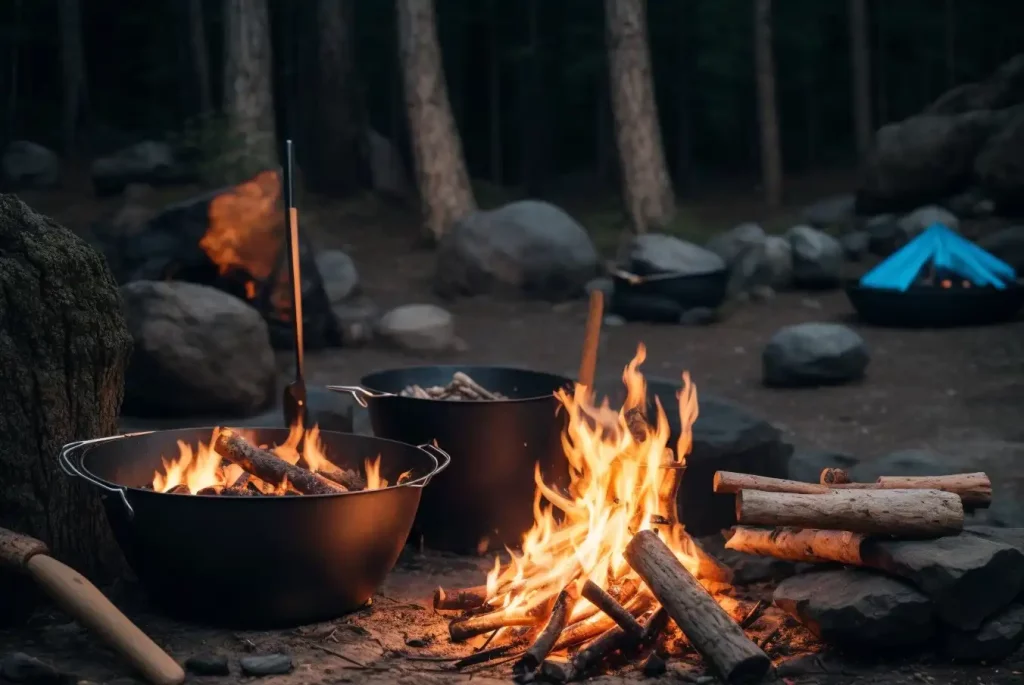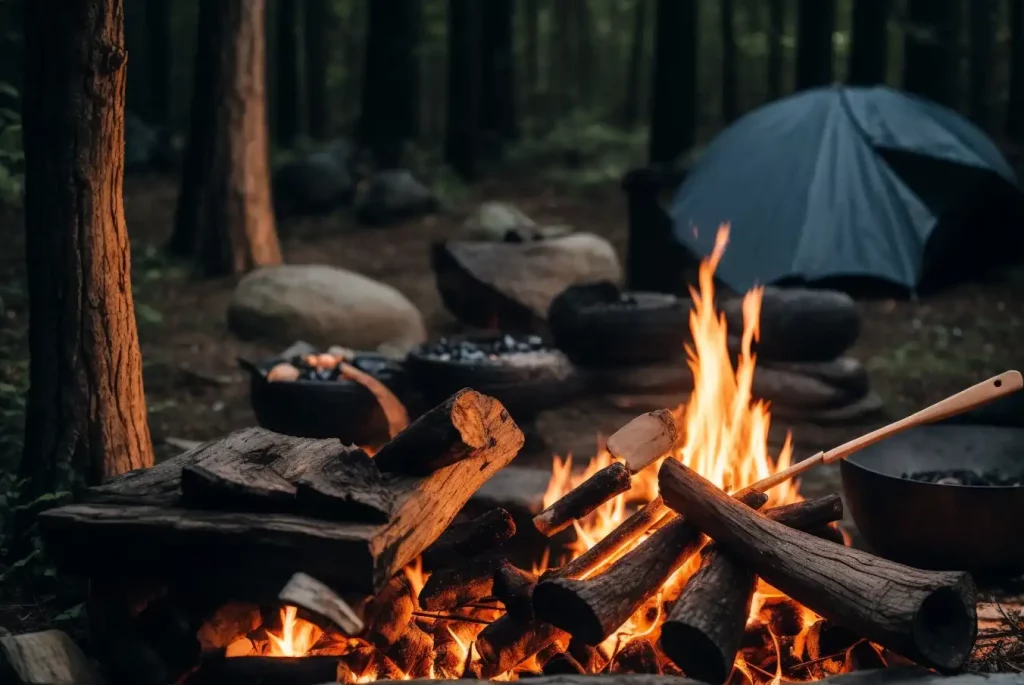Hey, fellow adventurers! So you’ve got your campfire roaring, and your stomach’s growling – what now?
Well, before you toss that steak or marshmallow into the flames, let’s chat utensils.
Yeah, you heard me. Wood, metal, or plastic?
Picking the right tools isn’t just a matter of taste, it’s a game-changer for your campfire cooking experience.
Stick around, because we’re diving deep into what makes each material tick.
You might just find that the right utensil is the missing ingredient in your outdoor culinary masterpiece.
The Importance of Material in Campfire Cooking
Okay, let’s get straight to the point: material matters, folks.
Imagine you’re flipping that perfect, sizzling burger.
One wrong move with a flimsy plastic spatula, and boom! Melted plastic mess ruins the meal.
Or consider stirring a hearty campfire stew with a wooden spoon that hasn’t been properly treated.
Before you know it, you’re chewing on wood splinters instead of delicious bites.
Choosing the right utensil material is crucial not just for taste, but also for safety.
Different materials conduct heat differently, and that’s a big deal when you’re cooking over an open flame.
Some materials may also react with the food you’re cooking, giving you unwanted flavors or even health risks.
Trust me, nobody wants a metallic-tasting marshmallow.
In essence, the wrong choice can turn your culinary adventure into a gastronomic mishap.
It’s not just about aesthetics or ease of use.
It’s about maximizing the joy of cooking and eating in the great outdoors, where every moment should be a cherished experience.
Alright, are you ready to delve into the nitty-gritty of each material?

Also know more: Biodegradable Vs Reusable Utensils
Criteria for Choosing the Right Utensils
So, you’re on board with picking the right material, but how do we narrow down our options?
There are three major things to consider: heat resistance, durability, and usability.
Get these factors right, and you’re well on your way to becoming a campfire cooking guru.
Let’s dive in!
Heat Resistance
First up is heat resistance.
You’re cooking on an open flame, so you need utensils that can stand the heat, literally!
Metal utensils, like stainless steel, are champs in this arena. They can take high heat without breaking a sweat.
Wood, while cozy and rustic, can be tricky. If you’re not careful, it can char or even catch fire.
And plastic? Unless it’s high-heat resistant plastic, keep it away from the flame. Melty spoons are not on the menu, folks!
Durability
Next, let’s talk longevity.
Metal utensils are your go-to if you want something that’ll last you through seasons of camping. They’re sturdy and resistant to wear.
Wooden utensils are generally durable, but they require some TLC. You need to treat them regularly to prevent cracking or splitting.
Plastic, unfortunately, tends to be the least durable. One drop, and it could be game over, especially if it’s not high-quality plastic.
Usability
Last but not least, usability is king.
Metal utensils often come with rubber or silicone handles, making it easier to grip. But be cautious; they can get hot.
Wood provides a naturally comfortable grip but beware of splinters in older or poorly maintained pieces.
Plastic is usually ergonomically designed, which is great, but remember its limitations in durability and heat resistance.
Know more: Responsible Campfire Cooking
Wood Utensils in Detail
Ah, the beauty of wood!
There’s something about using wooden utensils that just feels right when you’re out in nature.
But, like any material, wood has its ups and downs. Let’s get into it.
Pros of Wood
Wooden utensils have that rustic charm that just screams ‘outdoorsy.’
They are also poor conductors of heat, which means you’re less likely to burn your hands when stirring that pot of chili.
The wood is also kinder to your cookware, minimizing scratches and dings.
Plus, they usually don’t react with acidic or alkaline foods, so your grandma’s secret stew recipe will taste just as she intended.
Cons of Wood
On the flip side, wood requires maintenance.
You need to oil them regularly to prevent cracks and splinters.
They are also porous, meaning they can absorb flavors or even bacteria if not cleaned properly.
And, as I mentioned before, you gotta be cautious with heat. Leave that spoon too close to the flames, and you might have an impromptu bonfire on your hands.
Okay, feeling well-versed in wood now?
Metal Utensils in Detail
Alright, let’s talk metal. Metal utensils are like the Swiss Army knives of the campfire cooking world—versatile, strong, and efficient.
But hey, they’re not all sunshine and rainbows.
So let’s break down the pros and cons to help you decide if metal utensils are your jam.
Pros of Metal
Firstly, metal utensils are durable as heck.
These bad boys can withstand the test of time, and some might even outlast you.
When it comes to heat resistance, they’re champs. You can toss ’em into a blazing fire and they won’t even flinch.
They’re also easy to clean. Just a quick wipe or rinse and you’re good to go!
One more bonus point: they’re often multifunctional. Think tongs that also act as a spatula. Now we’re cooking with gas—or, well, fire!
Cons of Metal
Now, let’s not forget the downsides.
Metal conducts heat. Fast. Ever grabbed a metal spoon that’s been sitting in a hot pot? Ouch!
They can also be a bit unfriendly to your cookware, especially if it’s non-stick. Scrapes and scratches, anyone?
And let’s not overlook the weight factor. If you’re going for a lightweight backpacking trip, metal may not be your best friend.
Plastic Utensils in Detail
Alright, onto plastic. Plastic utensils are like the rookies in a baseball team.
They have potential, but they’re not MVPs just yet.
Should you consider them for your next outdoor cooking extravaganza? Let’s find out.
Pros of Plastic
Plastic utensils are lightweight, making them great for those of you looking to shed every possible ounce from your pack.
They’re often more affordable than their metal and wooden counterparts, so you won’t break the bank.
Ease of use? Check. These utensils are usually ergonomically designed, which means holding them feels like a breeze.
And hey, they won’t scratch your non-stick cookware.
Cons of Plastic
Alright, it’s time for some real talk.
Plastic melts, and easily at that. So unless you’re a fan of plasticky-tasting food, keep ’em far from high heat.
Durability isn’t their strongest suit either. Drop them, step on them, and you might be one utensil short.
They can also be prone to staining, especially if you’re cooking foods with strong colors.
And let’s not forget the eco-aspect. Not all plastics are recyclable, so think about your footprint.
Comparative Analysis
Alright, crunch time, folks! We’ve dissected each material like it’s a frog in a high school biology class.
Now, let’s weigh them against each other.
I mean, how else are you going to make an informed decision for your next culinary adventure in the great outdoors?
Best for Heat Resistance
When it comes to playing it cool—or hot, in this case—metal utensils steal the show.
Wood can get charred, and plastic, well, let’s just say it might join your meal if it gets too hot.
So if you’re all about that high-heat, sizzling kind of cooking, metal is your go-to.
Best for Durability
Durability is a tricky one. Metal is sturdy, no doubt, but it’s not invincible to the elements.
However, compared to wood’s susceptibility to rot and plastic’s knack for breaking or melting, metal takes the cake.
So, if you’re looking for a utensil that will stick around longer than your camping buddies, metal is the answer.
Best for Usability
Okay, now usability is where things get interesting.
Wood is light and doesn’t heat up like metal, making it super comfy to use.
Plastic is even lighter and often ergonomically designed, but remember, it has its limits.
Metal is the most versatile but can be heavier and might just scorch your fingertips if you’re not careful.
So, for an all-round user-friendly experience, wood has a slight edge, but just by a splinter!
Conclusion
So there you have it, folks! Wood, metal, or plastic—the great utensil debate decoded.
Each has its pros and cons, and the right choice largely depends on what you’re cooking and how you like to cook it.
Remember, heat resistance is metal’s playground. Durability? Metal again. But for usability, wood takes the trophy.
I hope this clears up any confusion you had.
The next time you find yourself huddled around a campfire, deciding whether to flip your burger with a metal spatula, a wooden spoon, or a plastic fork, you’ll know exactly what to do.
Catch you at the next campfire, chefs! 🏕️


